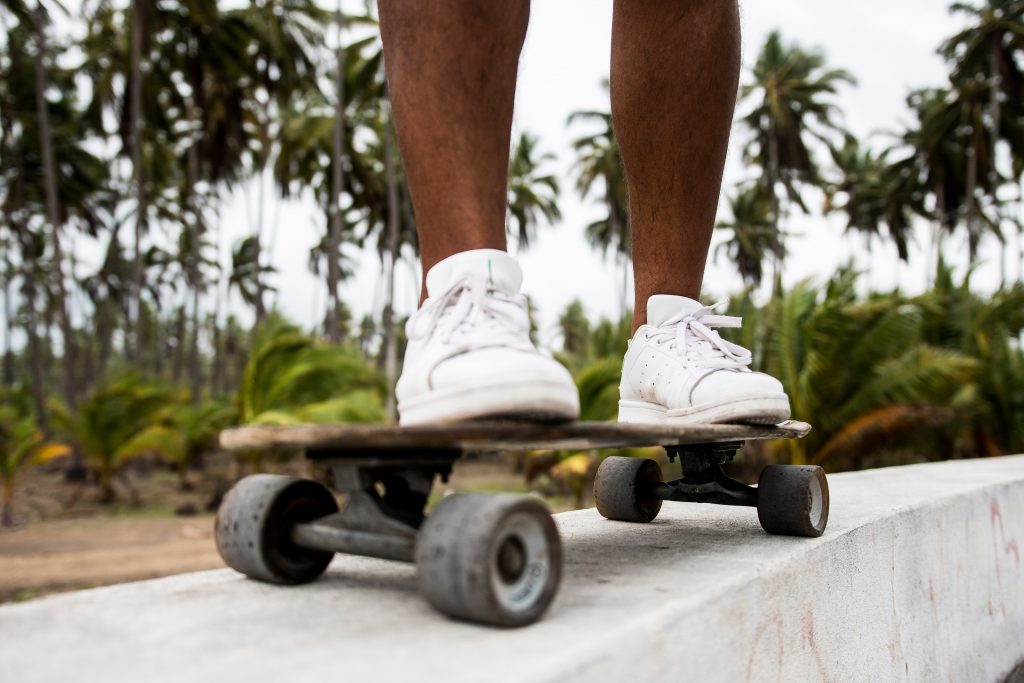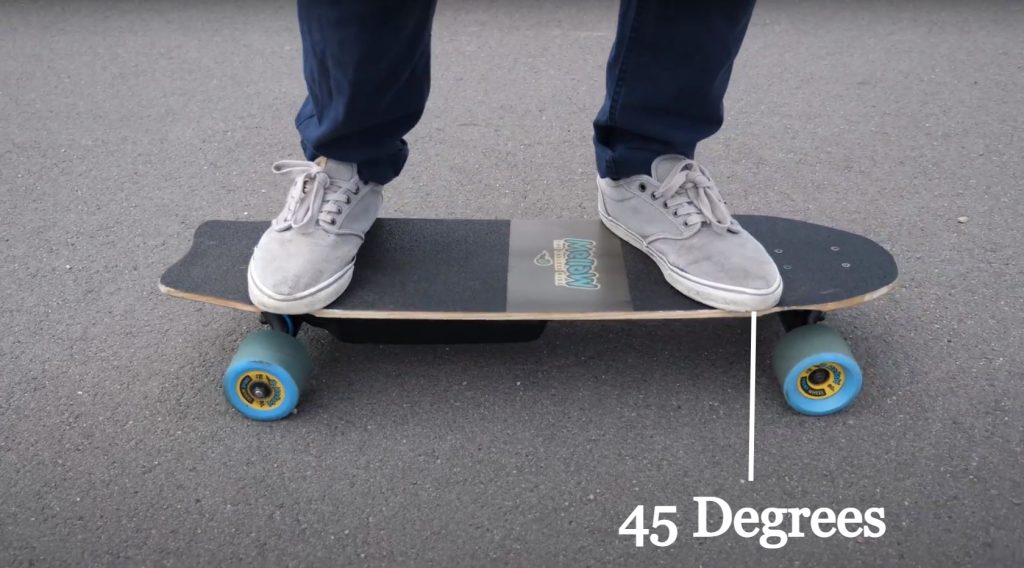A rudimentary factor of understanding the basics is how you stand on a longboard is called a longboard stance. Longboarding stance doesn’t reflect only the placement of riders’ feet on the board, but it also depicts the overall body position during the ride. Stance on a longboard depends on the riding style and a few other things. Speaking of riding styles, there are various like carving, cruising, sliding, dancing, and freeride. In each of these techniques, the foot placement and body positioning vary.
Besides feet, body positioning also includes management of hips, shoulders, and bending of the riders’ knees. In this post, we will briefly explain the multiple stances you can opt for while riding a longboard. So first of all, identify your preferred riding way and BoardsOnTop will do the rest.
Longboard Stance – Feet Placement

Generally, when a rider is riding the longboard, the rider’s body stays at the right angle concerning the direction of a moving longboard. An essential thing for a newbie rider is to know about his/her dominant foot; i.e., left or right. Everyone prefers placing his/her dominant foot in front and the other one at the back. It doesn’t matter which foot you keep in front, what matters is your body positioning according to the feet.
The purposes of the back foot are to steer the ride, provide control, and precisely push or brake. From the recent description, it becomes clear that knowing footedness is the most crucial thing before riding a longboard. If you place your dominant foot at the back, you’ll not be able to control during most of the ride. Most importantly, the same law applies for those who like riding a skateboard.
If we talk about stats, most riders prefer to keep their left foot at the nose of the longboard and the right one at the tail. As a matter of fact, the right foot is more often the dominant one, being controlled by the left part of the brain. Hence, we call this positioning a regular stance. On the other hand, goofy stance asks skaters to place their right foot ahead and the left one at the back of the longboard. Interestingly, you will also learn everything about regular and goofy stance here.
There are a few easy testing processes that you can go through to know if you are a regular or a goofy rider. Ask someone to push you from the back while you are standing still, due to which you will naturally lose balance. The foot that comes ahead instantly for regaining the lost balance, is your dominant foot. Another simplest test to know your dominant foot is to kick a ball with your natural foot.
Longboard Stance for Cruising
One of the most common riding styles among thousands of skaters around the globe is cruising on a longboard. Cruising means generally roaming around the streets or skate parks to enjoy and relax a bit. While longboard cruising, you must have a clear idea about your natural foot. Whatever the boarding you like, your stance on a longboard stays almost similar.
Placement of feet while cruising:
Both feet should stay wider than the width between your shoulders or at an equal distance. Making it more simpler and easier for you, keep the front foot over the front truck of the longboard and the back foot at the back truck. You should keep the back foot perpendicular to the board and the front foot should stay slightly titled at 45 degrees according to the board. Keep in mind that the angle will be changed with the board’s width.

Knee Positioning:
Cruising is widely known as the relaxing riding style. Therefore, your stance on the longboard should be as lenient as possible. Most often, when newbies try out cruising, they love riding a longboard for hours. Cruising demands bending of the knees only when you want to balance a high-speed longboard or bear minor shocks created through road cracks. As cruising is just roaming on a longboard, it doesn’t require professional skills in balancing the longboard.
Hips & Shoulders:
Keep the shoulders and hips at 90 degrees to the board. That is all you need to do to enjoy the ultimate experience of cruising on a longboard.
Longboard Stance while Pushing
When you are on a moving longboard, your stance is entirely different from the stance you need to push a longboard.
Feet Placement while Pushing:
Generally, newbies and rough professionals use their back foot to push the longboard to gain more speed. In this case, they like their front foot to balance the board. Other professionals do the opposite style of pushing; i.e., pushing with their front foot and steering the longboard with their back foot. Both stances are equally good for pushing, but I prefer to use my back foot to handle the longboard while pushing it with my front foot. It might seem a little difficult at the start to do what I do, but once you get used to it, this process becomes more straightforward and you will see the benefits yourselves.
Knees Positioning while Pushing:
Squat down the leg that you use to push the longboard. The more you squat it, the more power you will install in pushing. As a result, you will get the speed accordingly.
Hips & Shoulders:
The most natural position of your shoulders while pushing the longboard is to keep ahead in the direction of your movement. The more force you apply in pushing, the more your shoulders go ahead. On the other hand, the hips stay in a general position and have nothing to do with pushing the longboard, as they always follow the positioning of shoulders.
Longboard Stance while Braking
Braking stance somehow matches the stance when you try to push the longboard. In this case, the body above the hips is entirely facing forwards, squat down slightly to lower the dominant foot, keeping it in a straight line as your front foot. The difference comes when you do not need to push the ground. Instead, you will have to use the back heel to keep the toes up, helping you brush against the skating surface. Join an in-depth discussion on “how to stop on a longboard“.
Longboard Stance while Sliding
There are various types of slides invented by skaters around the globe. Each of them requires a different stance to perform the slide without getting into the danger of injury.
Feet Placement while Sliding:
Keep both the feet in a symmetrical manner, 90 degrees to the deck. Make sure that the distance between feet is more than the width between your shoulders. Following this stance, your heels stand very close to the heelside rail of the longboard. If something seems not understandable read, Longboarding Sliding at BoardsOnTop to know everything about sliding.
Knee Position while Sliding:
Lengthening the legs to keep the board away while bending your knees brings enough strength to make a powerful and injury-free slide.
Hips & Shoulders:
Keep both the shoulders and hips widened, and they should stay at a right angle to the deck of your longboard. Don’t lose this position during the drifting procedure, handle yourself when the slide is done.
Longboard Stance to Generate Speed
Your position and stance equally matter to gain a high pace on a longboard. You can keep this position in both normal rides and downhill rides. From the beginning to the end of the ride, your stance remains the same but you may need to change your position depending on the situations. The positioning of your body parts while generating pace is called tuck. Let’s see how does it work.
Knees:
Knees will be discussed first as they play a vital role during the fast longboard rides. Experienced riders always put most of their weight on their front knee while it is bent at an angle of 90 degrees. It is one of the easiest and most effective ways to bring maximum speed to your ride. Moreover, your knee in the back will go against the calf in front. So, we can say that the back knee has an automated or natural location.
Feet Positioning when riding faster:
Let’s talk about the front foot (according to your longboard stance) first. It is placed in a location that has an angle of around 20 degrees with the deck. This will make your front foot stand near to the front truck of your longboard.
The angle of your back foot remains the same as the front one but in a different position. Make sure you give your backfoot a parallel position to the foot in front. The distance between your back foot and the endpoint of the deck should be a little more than the front one. For better understanding, go for the one-foot distance in your back foot and tail side of the longboard. Also, look at the image attached below for better understanding.

Shoulders, Hips, and Torso:
Let your hips and shoulders go in the position they want to once your knees are bent. It will make sure that your shoulders are in the forward location while your hips also forward but not too turned like shoulders. Make sure that the tuck position should get as much response from your hips as possible. In this whole scenario, your torso will automatically be bent forward in a horizontal shape. For the hands, simply keep them on your back, and you are done with the longboard tuck positioning.
FAQs
How should you stand on a longboard?
If you know your longboard stance very well, you will not get conflict on how to stand on a longboard. The only thing matters in longboarding foot placement is your stance. Because in this case, your right and left both feet can be your front foot. To know your longboard stance, you try both feet and choose one as a front foot that pushes the longboard harder.
Which foot should be used for pushing the longboard?
You place one of your feet in front and one in the back and everyone knows that. To keep it simple, you always push with the back foot which can be either your right or left depending on the longboard stance.
Where to put front foot on a longboard?
Due to various riding styles, we can’t specify where should you place the front foot on deck. The best practice would be to know your riding style first. The beginners can put at the beginning point of trucks for maximum stability while freestyle riders can try out different placements.
Final Words
No matter if you are a newbie in longboarding or an advanced-level longboard rider. You will always have to be completely known of the longboard stance. While riding the longboard in any style, the stance will remain the same because it is natural. Although the foot placement and positioning of other body parts will be changed according to the riding style. All of these topics have been discussed earlier, so you just have to specify how do you like to ride your board and learn about how to stand, where to stand, and the position of your different body parts.
